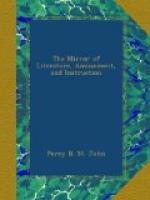Patronage, royal and noble, has already achieved much for painting, and even the reported project for a National Gallery does much to foster the art. It keeps the study afloat and uppermost in the public mind; and the immense increase of exhibitions, not only in London, but in provincial towns, serves to prove that patronage now consists in something more substantial than tutelar notice, and unpaid promises. Artists need no longer journey to the metropolis to find sale for their works, for their genius is nourished on its native soil by the liberality and good taste which abound in the neighbourhood of every important town in the empire. It may be as well to keep up the hue and cry about the folly of portrait-painting, if it be only to keep down the vanity of wealth; but the munificent rewards which painters receive for this branch of their art will enable them to devote a greater portion of their leisure to higher studies. Their taste will not thus be impugned; for Cooke, the actor, is known to have entertained the meanest opinion of his own performance of Richard the Third, as an historical portrait, notwithstanding it was the corner-stone of his fame. We do not invite the comparison; but Mr. Hayden began with history—his want of patronage is well known; he then tried portraits—but his want of success was reserved for the style of his Mock Election pictures, and, in all probability, they will turn out the philosopher’s stone for his future life.
But it is to the splendid union of Painting, Engraving, and Literature that much of these beneficial effects may be traced. In every branch of the fine arts and literature, what a powerful influence will this triple advancement produce. Only compare the topographical works of Mr. Britton with those of his predecessors—his highly-finished line engravings, excellent antiquarian pieces on wood, and erudite descriptions, with the wretched prints and the quaintnesses of old topographers—or even with the lumber of some of our county histories. With this improvement, and that of map-work, painting has comparatively but little to do; and yet how evident is the progress of the literature of these works.[2]
It would be easy to adduce hundreds of instances of the recent union of painting and engraving. About five years ago, a plan was started for illustrating the Bible from pictures of the old masters. Upwards of two hundred of them were transferred to wood-blocks; but the scheme did not repay the ingenious originator—partly from their small size, uncertainty of effect to be produced on wood, and partly from the very cheap rate at which the engravings were sold—the whole series being purchaseable for three or four shillings.[3] But a similar design is now in progress on metal, being the idea of La Musee in little. It consists of beautiful outline copies of the great masters, published at so cheap a rate as to be within the reach of a school-boy. Within the present year, also, two series of Views in Great Britain, one of Views in London, and another of Paris, have been publishing at the rate of threepence for each view; and when we see among their artists the names of Westall, Pugin, and Pye, we have a sufficient voucher for their excellence.




